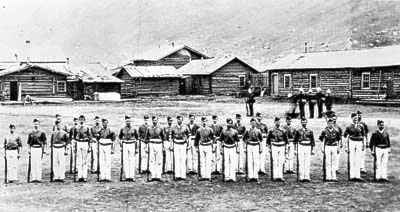The life of a Klondike gold rush stampeder wasn’t pretty.
Fresh food was scarce, diseases such as typhoid ripped through the population, and the long, rough journey took its toll on many tempers.
The modest contingent of North-West Mounted Police officers sent to the Yukon at the time was charged with caring for these men. They were busy. They settled disputes, delivered mail, protected gold shipments and protected Canada’s sovereignty from the American threat from across the border.
When an influx of wide-eyed miners seeking gold on the creeks in the Klondike overtaxed the resources of the Mounties in the Yukon at the time, Ottawa called in the cavalry.
In March 1898, an order-in-council authorized the formation of the Yukon Field Force, a unit of 203 volunteer officers and men from the Canadian Militia’s infantry, artillery and cavalry.
Its men were drawn from military bases in New Brunswick, Quebec and Ontario and they didn’t know what to expect in the Yukon.
In an effort to make the posting more attractive to the soldiers the government issued them double pay after leaving Vancouver. This meant that a private earned the princely sum of 80 cents per day.
The unit began its trip to the Yukon from Ottawa. It travelled from Vancouver to Wrangell, Alaska. They went along the Stikine River to Glenora, and then they marched overland to Teslin Lake.
The men were accompanied by just six women: four from the Victorian Order of Nurses, a wife of a NWMP Inspector and Miss Faith Fenton, a newspaper correspondent from Toronto (one of Canada’s first female journalists).
One hundred tons of supplies and provisions were packed from Glenora. Small boats and scows were built at Teslin Lake for river travel along the Hootalinqua and Yukon rivers.
Fifty men were sent ahead from Telegraph Creek to construct log barracks at Fort Selkirk. The rest of the Yukon Field Force arrived in Fort Selkirk September 11th, 1898.
The troops’ routine duties included guarding the gold banks and assisting in collecting the government duty on all gold brought out of the country.
In October 1898, 50 of the men were sent on to Dawson City. And there they took on a much different challenge. They were called upon to douse a blaze that had set the town on fire.
“A carouse in the Monte Carlo theatre had resulted in an upset oil lamp and a score of buildings were blazing furiously,” reads an account of the Yukon Field Force in the Canadian Army Journal.
“The danger intensified when certain of the civilian salvage crews discovered whiskey in a blazing saloon, dragged a half dozen barrels to the street, stove in the tops and invited all so inclined to drink as much as they wanted.
“Meanwhile the flames swept on.”
Though blocks of the town lay in ashes, there would have been much more damage if the field force had not pitched in to help, reads the same article.
The force’s headquarters were moved to Dawson City in the summer of 1899.
Their duties were withdrawn by July 1, 1900, and replaced by a unit of non-permanent militia known as the Dawson City Rifles.
“We were very sorry indeed to see them depart, for they were generous comrades and good soldiers, and had been of great assistance to us (the Mounted Police),” wrote Sam Steele in his book Forty Years in Canada.
The troops returned home in time to mobilize for the war in South Africa.
